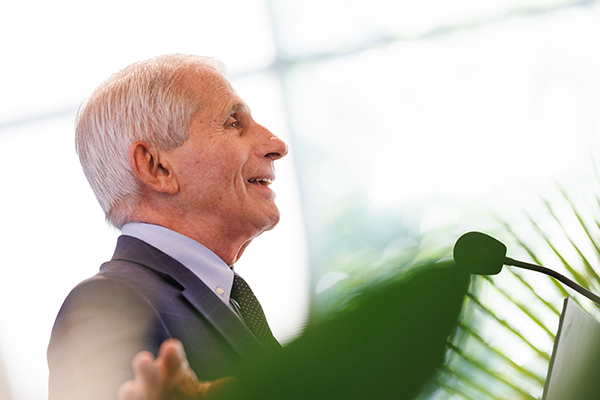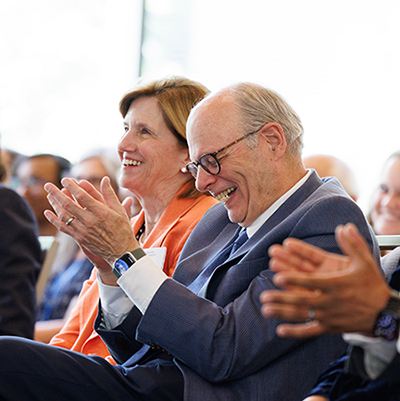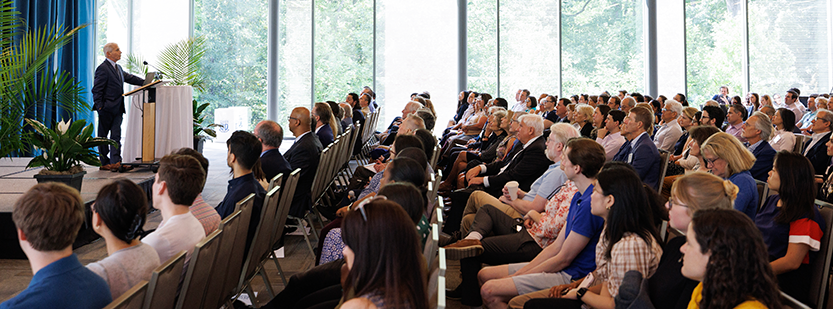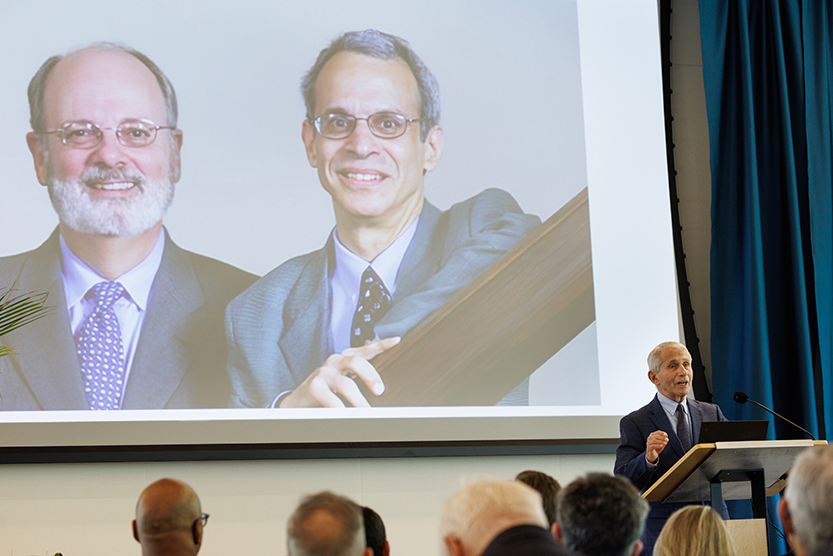
Anthony S. Fauci, MD, was chief of the Laboratory of Immunoregulation at the National Institute of Allergy and Infectious Disease (NIAID) when he read about a strange form of pneumonia that had killed more than two dozen young, otherwise healthy gay men in Los Angeles in the span of a month.
It was 1981. Fauci was intrigued. He decided to devote his attention to studying this mysterious disease that, at that point, did not even have a name. That decision set him on a scientific and political path he could scarcely have imagined.

Fauci, who was director of NIAID from 1984 to 2022 and has served as a key advisor to seven U.S. presidents, shared the story of his career with a large audience in Duke University’s Penn Pavilion on May 22 as he delivered the Norman L. Letvin, MD, Memorial Lecture.
Fauci, now a distinguished university professor at Georgetown University School of Medicine and a distinguished senior scholar at the O’Neill Institute for National and Global Health Law at Georgetown, came to Duke at the invitation of Bart Haynes, MD, Frederic M. Hanes Distinguished Professor of Medicine and director of the Duke Human Vaccine Institute (DHVI).
Mary E. Klotman, MD, executive vice president for health affairs at Duke University and dean of Duke University School of Medicine, delivered opening remarks. Haynes then introduced Fauci, a mentor and friend, to the 450 people in attendance and another 750 watching via livestream.
“He is, without a doubt, one of the most competent and caring physicians I have ever known, and the best mentor I could have ever imagined,” Haynes said of Fauci.
The Nascent Phase
Fauci took the audience on a journey through time spanning his 58-year career, which began after he graduated from Cornell Medical School (now Weill Cornell) in 1966. In 1968, he joined NIAID’s Laboratory of Clinical Investigation, and in 1980 he was appointed chief of the Laboratory of Immunoregulation.
The following year, the first reports began to emerge about the strange new disease striking gay men. The next year the disease was named Acquired Immune Deficiency Syndrome, or AIDS.
In the early days, with no treatment options, the prognosis for patients with AIDS was grim: 49% survival rate at one year, and a mere 15% survival rate within five years.
Fauci called that period the “dark days” of his medical career. “I hope people in the medical field,” he said, “don’t ever have to experience making rounds day after day on patients you have absolutely no therapy for.”

Pivoting Towards Progress
Fauci became director of NIAID in 1984, expanding his reach not only in science but also politics.
In 1985, in clinical trials at Duke and several other institutions, a failed cancer drug called AZT proved effective at blocking HIV. The Food and Drug Administration (FDA) approved AZT in 1987, faster than any drug in its history. The next step was making it accessible.
AIDS activists wanted a voice in the discussion. Rather than shy away from them, Fauci embraced them.
“I asked them to come into my office, and we sat down and began a dialogue that completely turned me around to become an activist for their cause,” Fauci said.
“In my own experience as a physician and as a public health person … ultimately one of the most productive and positively impactful activities I’ve seen in medicine was the beginning of AIDS activism,” Fauci said.
Fauci’s work on AIDS kept him in close contact with Haynes, who had worked under him at NIAID. Haynes established the DHVI in 1990 to conduct research on vaccines and therapeutics for HIV/AIDS. In 2005, the Duke Human Vaccine Institute was awarded a $350 million NIAID-funded Center for HIV/AIDS Vaccine Immunology (CHAVI) grant. DHVI has received several subsequent CHAVI-related grants to continue work on HIV/AIDS vaccines.
Hope Lights the Way Forward
Haynes organized Fauci’s lecture to honor the life and legacy of another pioneering HIV researcher, the late Norman Letvin, MD, who was a professor of medicine at Harvard Medical School and chief of the Division of Viral Pathogenesis in the Department of Medicine at Beth Israel Deaconess Medical Center. Letvin and Haynes began an important scientific collaboration and lifelong friendship in 1991. Their work together resulted in 55 papers and has been called one of the most important collaborations in HIV vaccine research.
Letvin died from pancreatic cancer in 2012. His wife, Marion Stein, MD, gave an endowed gift of $6.6 million to DHVI in memory of Letvin and in honor of Haynes.

AIDS and HIV treatment has come a long way from the “dark days” of the 1980s before any treatments existed, Fauci said. The progress that began with AZT grew into combination treatments that render the virus virtually undetectable.
“Today, in 2024,” Fauci said, “if you treat someone in their mid-twenties or thirties early in the course of the disease, you can tell them they would very likely live an additional 56 years, which puts their life expectancies maybe one or two years less than someone otherwise healthy.”
But the AIDS epidemic is far from over. In 2022, 630,000 people died from AIDS, and 39 million people were living with HIV. The vast majority — 30 million — are on therapies, but the other 9 million are not.
The biggest need — a vaccine — has remained elusive.
We may be getting closer, though, thanks to Haynes and his colleagues at DHVI, Fauci said. Researchers at DHVI have made a series of breakthroughs in recent months. Fauci noted three papers that all have come out in the last year from Haynes and DHVI that have “hit it right out of the ballpark.”
“We are going to get a vaccine,” Fauci said, “and [DHVI’s research] provides a proof of concept that an HIV vaccine that induces broadly neutralizing antibodies is possible.”
Photos by Eamon Queeney, Assistant Director, Multimedia & Creative